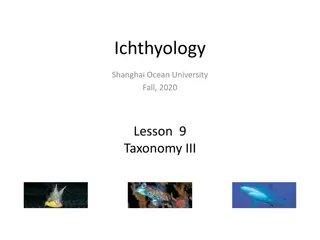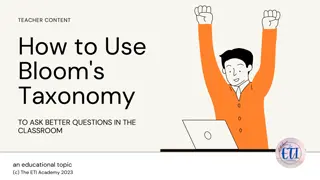Sustainable Fashion Solutions for Repurposing Formal Wear
Transforming formal wear from single-use items into sustainable fashion solutions is vital for reducing textile waste and environmental impact. This article explores the challenges of post-party formal dresses, the environmental consequences of textile waste, and innovative approaches to upcycling d
9 views • 14 slides
Understanding EU Taxonomy and Green Asset Ratio Update
Delve into the latest updates on EU Taxonomy and Green Asset Ratio, legislation, reporting obligations for large companies, and key performance indicators for reporting under EU Taxonomy. Explore how the European Commission's Action Plan on Sustainable Finance and the EU Green Deal are shaping ESG r
145 views • 18 slides
Transparency in Financial Markets: EU Taxonomy, SFDR, and Sustainability Reports Overview
This content discusses the importance of transparency in financial markets through the interplay of EU Taxonomy Regulation, SFDR, and sustainability reports. It emphasizes the objective of enforcing sustainability information to enhance investor decision-making processes and market confidence. The E
11 views • 10 slides
ELENA Grants: Supporting Sustainable Investments for a Greener Future
ELENA grants provide support for various sustainable investments, including sustainable energy projects, residential renovations, sustainable urban transport initiatives, and more. With a minimum investment requirement of 30 million, ELENA focuses on mature projects with investment returns within 3/
0 views • 30 slides
Understanding Taxonomies in Sustainable Development
Explore the significance of taxonomies in relation to indicators for sustainable development goals (SDGs) and the EU Taxonomy for sustainable activities. Learn how indicators are defined, their role in evaluating economic and environmental activities, and the importance of a standardized taxonomy fo
12 views • 47 slides
Sustainable Financing for Climate Adaptation: Mexico's Innovative Approach
Mexico's Ministry of Finance is pioneering sustainable financing for climate adaptation through policy instruments like the Sustainable Taxonomy. The country's focus on mobilizing financing for adaptation, in line with NAPs and NDCs, showcases a unique global leadership in incorporating social objec
5 views • 4 slides
Sustainable Development as Fundamental Pillar of Global Economic Governance Reform
The need for reform in global economic governance is emphasized for achieving sustainable and shared growth. Key issues include debt burden reduction, sustainable finance increase, and international trade system improvement. International commitments on human rights and sustainable development are n
1 views • 7 slides
Building Academic Success Through Cornell Notes & Memory Techniques
Explore the power of Cornell note-taking method and memory building in academic success. Learn about Bloom's Taxonomy, storing data, representing memory, and more in CSE 390B. Discover how to apply higher-order thinking skills in your academic responsibilities as a student. Dive into the practical a
1 views • 37 slides
Insights into Plant Taxonomy and Systematics by Dr. Habibur Rahman
This informative content delves into the aims and principles of plant taxonomy and systematics as elucidated by Dr. Habibur Rahman. It covers the significance of taxonomy in identification, classification based on natural affinities, inventory creation, evolution detection, and its integral role in
2 views • 34 slides
Advancing Low Carbon Development in Sustainable Transport
Thierry Nervale, Deputy Director of the Transport SPC EDD Programme, highlights the importance of sustainable transport in achieving economic growth, social equity, and environmental preservation. The UN Conference on Sustainable Development underscores the central role of transportation in sustaina
4 views • 17 slides
Enhancing Engineering Education with Bloom's Taxonomy: A COREN Webinar Overview
Explore the application of Bloom's Taxonomy in engineering education, focusing on understanding, analyzing, and improving the curriculum for Nigerian universities. Learn how this framework promotes critical thinking and guides assessment practices to elevate educational outcomes.
0 views • 40 slides
Understanding Bloom's Taxonomy and Educational Objectives
Explore the comprehensive concept of Bloom's Taxonomy and Educational Objectives developed by Prof. Benjamin S. Bloom and his associates. Learn about the cognitive, affective, and psychomotor domains, instructional objectives, and the interrelation of educational activities in shaping learners. Disc
1 views • 35 slides
Outcome-Based Education System and Bloom's Taxonomy in Engineering Education
Dr. Muhammad Mohsin Aman discusses a new system of accreditation focusing on Outcome-Based Education (OBE) in engineering education. The presentation covers Bloom's Taxonomy, OBE accreditation advantages, Washington Accord, engineering attributes, PEC and NED roles, educational objectives, learning
1 views • 61 slides
Overview of Bentham and Hooker's Classification System in Plant Taxonomy
Bentham and Hooker's system of classification in plant taxonomy, outlined in Genera Plantarum, provided detailed descriptions of families and genera based on original plant dissections. This classification system has practical value for plant identification, with keys for taxa and subdivisions for l
2 views • 47 slides
Corporate Sustainable Reporting and EU Taxonomy: A Compass for Europe's Recovery
This event held on September 14, 2021, explored the practical implications of corporate sustainable reporting and the EU Taxonomy for Europe's recovery. Key discussions included the European Sustainability Reporting Standards, moving from preparation to the elaboration phase, and the role of various
1 views • 16 slides
Overview of Platform on Sustainable Finance and EU Taxonomy
Platform on Sustainable Finance focuses on six environmental objectives including climate change, circular economy, pollution prevention, and biodiversity protection. It emphasizes science-based, easy-to-use features to contribute sustainably without significant harm. The EU Taxonomy identifies acti
3 views • 14 slides
Fundamentals of Taxonomy Explained: From Classification to Nomenclature
Taxonomy, derived from Greek roots, encompasses the science of classifying organisms and understanding their variations, evolutionary relationships, and naming conventions. It involves description, identification, classification, and nomenclature of both living and extinct organisms. The practices o
1 views • 39 slides
Embedding Education for Sustainable Development in the Curriculum: The Scottish College Project
Embedding Education for Sustainable Development (ESD) in the curriculum is crucial for meeting current needs without compromising the ability of future generations to meet their own needs. The concept of sustainable development encompasses social, environmental, and economic elements. Education for
6 views • 20 slides
Understanding Graduate Attributes and Essay Writing Structures
Explore the concepts of graduate attributes, essay writing structures, and SOLO taxonomy in education. Understand the levels of understanding using SOLO Taxonomy and learn about the PESEL methodology for effective essay writing. Discover ways to introduce academic essays and the importance of defini
0 views • 30 slides
Understanding Taxonomy and Scientific Classification
Explore the world of taxonomy and scientific classification, from the discipline of classifying organisms to assigning scientific names using binomial nomenclature. Learn the importance of italicizing scientific names, distinguish between species, and understand Linnaeus's system of classification.
0 views • 19 slides
Comprehensive Overview of RCEM Approach by Dr. Pooja Rani, Assistant Professor
Regional College of Education, Mysore (RCEM) introduces the RCEM Approach focusing on mental abilities over behavior, with its own taxonomy. Modifications to Blooms Taxonomy are discussed, emphasizing creativity. The approach outlines mental processes related to cognitive development objectives, hig
0 views • 7 slides
Molecular Advances in Phytosystematics Course Overview
Phytosystematics is a science focusing on plant taxonomy and classification, aiming to establish evolutionary relationships among plant species. Scientists use genetic analysis and physical characteristics to group plants into related taxa. Functional evolution, parallelism, and rapid divergence inf
0 views • 14 slides
Understanding Bacterial Taxonomy and Staining Techniques
Bacterial taxonomy involves classifying and identifying bacteria, while staining techniques such as Gram staining help differentiate between Gram-positive and Gram-negative bacteria. This article discusses the importance of distinguishing bacterial strains, preparing smears, and performing different
0 views • 17 slides
Evolutionary Contributions of Prominent Scientists in the 19th Century
Charles Darwin, Gregor Mendel, Friedrich Miescher, Aristotle, and Carl Linnaeus were key figures in the 19th century who made significant contributions to the fields of evolution, genetics, DNA discovery, and taxonomy. Darwin proposed the theory of evolution and natural selection, Mendel established
0 views • 20 slides
Synchronization in Distributed Systems: Examples and Taxonomy
Understanding the need for synchronization in distributed systems is vital for ensuring correct operation. Examples such as vehicle tracking and file writing highlight the importance of entities coordinating and agreeing on events and resource access. A broad taxonomy of synchronization reasons is d
2 views • 31 slides
Understanding Taxonomy and Classification Systems
Explore the world of taxonomy, classification, and binomial nomenclature through the works of Carl Linnaeus. From organizing items in closets to grouping organisms in a logical manner, discover the importance of naming and categorizing in a structured and systematic way.
0 views • 18 slides
Understanding Taxonomy and Classification in Biology
Scientists use classification to group organisms logically, making it easier to study life's diversity. Taxonomy assigns universally accepted names to organisms using binomial nomenclature. Carolus Linnaeus developed this system, organizing organisms into species, genus, family, order, class, phylum
0 views • 11 slides
Understanding Plant Taxonomy and Family Identification
Explore the world of plant taxonomy, from the basic processes of classification to identifying families based on shared characteristics. Learn how to distinguish different plant families and the challenges of using common names in the botanical world.
0 views • 24 slides
Understanding Plant Taxonomy: A Comprehensive Overview of Flowering Plants
Plant taxonomy involves the study of various characteristics such as morphology, anatomy, photochemistry, cytology, and palynology. It plays a crucial role in the classification and understanding of plants. This content explores the principles of flowering plants, university vision and mission state
0 views • 30 slides
Understanding Blooms Taxonomy in Educational Settings
In the classroom, understanding Bloom's Taxonomy is essential for effective teaching and learning. This taxonomy, created by Benjamin Bloom, categorizes levels of thinking skills from basic memorization to higher-order critical thinking. The revised Bloom's Taxonomy emphasizes the importance of prog
0 views • 24 slides
Understanding Bloom's Taxonomy: A Guide to Cognitive Levels
Blooms Taxonomy, developed by Benjamin Bloom, categorizes thinking into six cognitive levels, from remembering to creating. The original taxonomy includes knowledge, comprehension, and application as lower levels, and analysis, synthesis, and evaluation as higher levels. In the revised version, the
0 views • 10 slides
A Fascinating Dive into the World of Fish Taxonomy - Ichthyology Lesson Highlights
Explore the intriguing world of fish taxonomy through a captivating Ichthyology lesson at Shanghai Ocean University in Fall 2020. Delve into the diverse families such as Percidae, Xiphiidae, Scombridae, Pleuronectidae, and Tetraodontidae, discovering unique features and characteristics of fish speci
0 views • 19 slides
Field Visits and Herbarium Techniques in Plant Taxonomy
This material covers the field visits and specimen collection process in plant taxonomy, emphasizing the need for complete specimens with tools required. It explains the pressing, drying, mounting, and preservation techniques involved in creating herbarium specimens for study and research purposes.
0 views • 19 slides
Exploring National Occupational Classification and Taxonomy Updates
Discover the process of revising the National Occupational Classification (NOC), including the joint efforts of ESDC and Statistics Canada, continuous updates, and the upcoming launch of a Collaborative Platform. Learn about the skills and competencies taxonomy associated with the NOC and how stakeh
0 views • 5 slides
Automated Knowledge Base Construction: Taxonomy Induction and Entity Disambiguation Overview
Explore the foundations of automated knowledge base construction through taxonomy induction and entity disambiguation frameworks. Learn about organizing and distinguishing entity types, the significance of structuring entities like physicists, villages, and chemical formulas. Delve into the inputs,
0 views • 53 slides
Sustainable Education: Empowering Learning for a Greener Future
Dive into the world of sustainability education with instructors Liz Potter-Nelson and Sarah Meyers from MIT's Environmental Solutions Initiative. Explore effective teaching methods, sustainable learning approaches, and paradigms that shape education for a more sustainable world. Gain insights into
0 views • 32 slides
A Comparative Study of Blooms Digital Taxonomy in Virtual and Conventional Universities
This study presented at the 33rd Annual Conference of the Asian Association of Open Universities focuses on the comparison of knowledge and use of Blooms Digital Taxonomy by teachers and students in virtual and conventional universities. It explores the impact of integrating digital tools in educati
0 views • 24 slides
Understanding Bloom's Taxonomy of Learning Domains
Bloom's Taxonomy, developed in 1956, focuses on promoting higher-order thinking in education. It categorizes learning into three domains: Cognitive (knowledge), Psychomotor (manual skills), and Affective (attitude). While Bloom's committee initially omitted the Psychomotor domain due to teaching lim
0 views • 19 slides
Enhancing Classroom Questioning Using Bloom's Taxonomy
Bloom's Taxonomy, developed by Benjamin Bloom in 1956, offers a framework for educators to set educational goals and assess students' understanding. This taxonomy consists of different levels - Remember, Understand, and Apply - guiding teachers to ask questions that promote critical thinking and dee
0 views • 11 slides
EU Sustainable Finance Taxonomy Overview and Regulations
The EU Sustainable Finance Taxonomy is not a mandatory list for investment but a tool to aid informed decisions. It focuses on environmentally sustainable economic activities, with a technology-neutral approach. The taxonomy aims to facilitate the transition of polluting sectors, promote transparenc
0 views • 22 slides







































